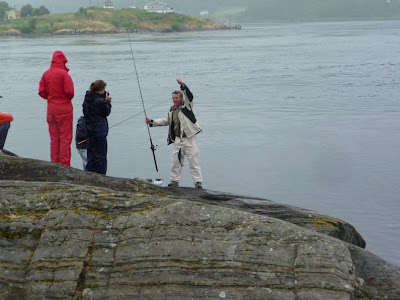We arrived in Bodo late in the evening, ascertained that we would not be getting on the 10PM ferry, and so spent the night in the noisy ferry car park. Early the morning of the 17th we just missed the 4:30AM ferry but did make the 6AM ferry; perhaps not two dozen people and a dozen vehicles aboard. There were light swells once at sea (a long time, given the size of the harbor and number of skerries), and even the Norwegian sea was nearly glassy, like the fiords we have seen. It was an uneventful 4 hour cruise. We arrived at Moskenes, in the Lofoten islands, about 10 AM, visited the TI, and proceeded to drive the E10, the length of the islands, stopping frequently, sometimes every couple hundred meters, to look at and photgraph the incredible scenery here.
Norway's Atlantic coast consists of the fiords and of thousands upon thousands of islands. But, unlike what we saw in Sweden and Finland, the islands are not skerries, rising only enough to support a small forest or some summer homes. In Norway, they are mountains rising from the sea, and nowhere is this more dramatic than in the Lofoten chain of islands that spread west of northern Norway. The mountains are not high by any standard, but at this latitude—67 degrees and more—they have all the features of their larger alpine cousins: glaciers, peaks chiseled by glaciers, tarns, waterfalls, snow, and everywhere the sea, more fiords, more maelstraums, and so on. Add to this the fishing culture that has been going on here for aeons, since paleolithic times, the more recent cod and minke whale industries...it is a pretty fascinating place. With every bend in the road and sight, we commented that one could spend months here, hiking, climbing, walking beaches and fiords, and only scratch the surface. Well,
summer months; although the mean winter temperature here is only -2 Celsius, probably very comparable to dear Missoula. That good old Gulf Stream at work again. But one suspects it never really warms up very much, and that the other 10 months are not so wonderful. We camped on a fiord again, in light rain, and 47 Fahrenheit outside. Still it's an incredibly neat place, well worth the 3 stars, and we have seen only half of it so far. Oh, we looked at our worn world map, and, to our surprise, discovered that we are relatively far to the north of even Iceland now.
Earlier in the day I bought a lure and went fisking again. Last time was a wash, but this time the fish won: I lost my 29 kroner souvenir lure to the rocks and weeds.
 |
| Our ferry, in the Moskenes harbor |
 |
| Our first view, from a few miles out |
 |
| The more southerly islands...no bridge to them |
 |
We decided to do the villages in alphabetical order; fortunately, A was at the
southern tip of Moskenes (OK, if you know your Norwegian alphabet, you know
that the superscripted letters come at the end) |
 |
| Boats on a fiordlet |
 |
| Skerries and peaks |
 |
| Fish drying racks and peaks |
 |
| More peaks |
 |
| Fishing village on Moskenes |
 |
| Village and peaks |





















































